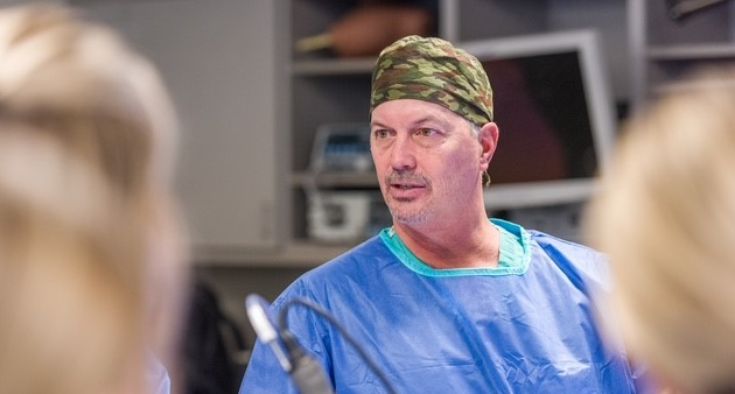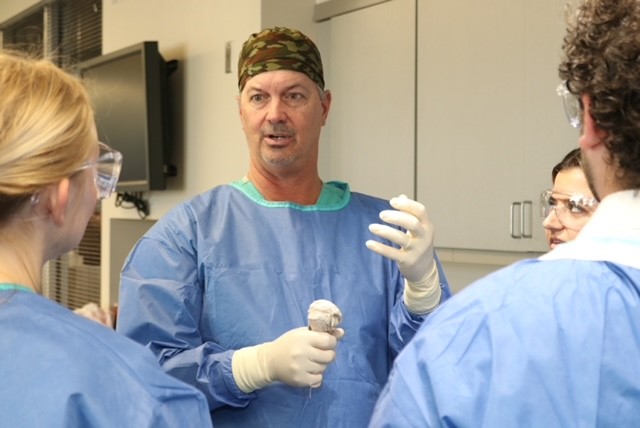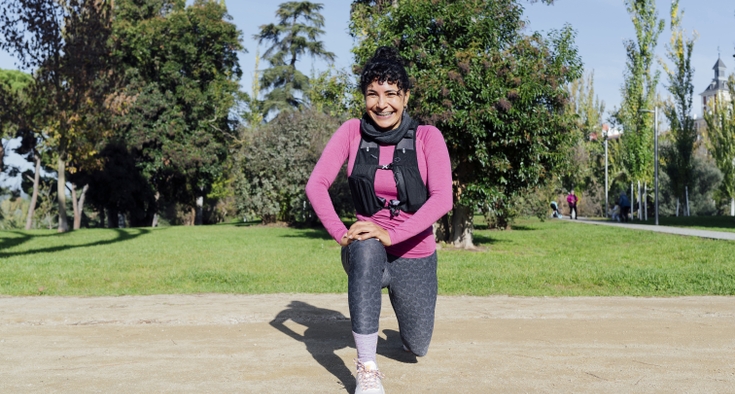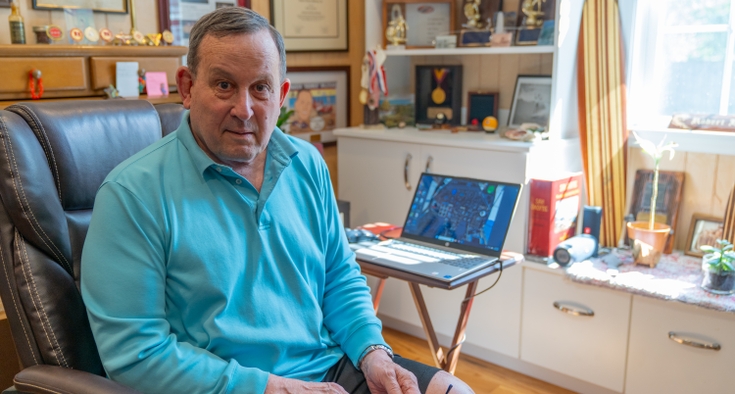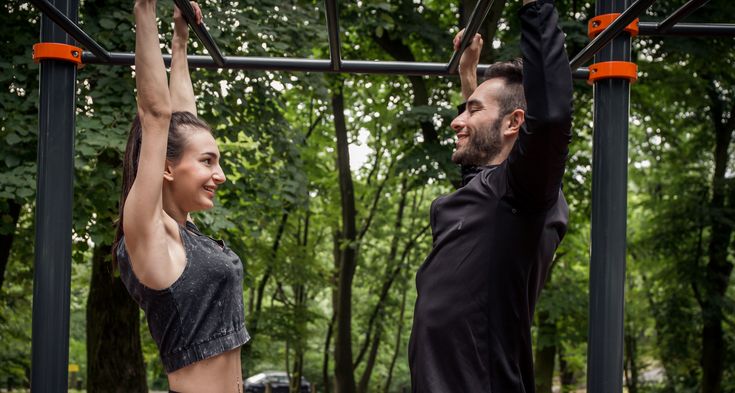Dr. Michael (“Mike”) Kissenberth can relate to the athletes. After all, he’s an athlete himself. And a tragic accident that paralyzed a football teammate is what led him down the path he continues to follow today.

His love of playing sports bloomed in high school, where the now-distinguished orthopedic surgeon played football, basketball and baseball and ran track.
His early years were spent in Santa Monica, California, before his rocket-scientist father took a job in Florida at the Kennedy Space Center. Because he grew up on two coasts, surfing was also part of his repertoire. “I did everything but golf,” he said. “I should’ve learned that at a younger age, but I’m trying to figure it out now.”
In college, he played linebacker at The Citadel, where he made lifelong friends. “When you’re part of a team and go through drills, wins and losses together,” he said, “that bond you form stays with you forever.”
Dr. Michael Kissenberth
Find the orthopedic care you deserve.
After serving in the U.S. Army for 12 years as an orthopedic surgeon, Kissenberth settled in Greenville, South Carolina, where he’s spent the past two decades treating athletes. The procedures he performs most often are shoulder replacement surgery, rotator cuff repair, shoulder stabilization procedures, elbow surgery and ligament reconstructive surgeries.
But he also travels extensively as a teacher, lecturer, researcher and consultant. Since 2005, he’s consulted with the Colorado Rockies, the Denver-based Major League Baseball (MLB) team. In addition, he’s been team physician for the Greenville Drive (the local affiliate of the MLB Boston Red Sox), local universities and many high schools.
When Novant Health chose to expand into the Greenville region, Kissenberth was the top choice to lead the practice. He officially joined this summer and is currently seeing patients at his new clinic, Novant Health Orthopedics & Sports Medicine, located on Congaree Road in Greenville.
Kissenberth is the first doctor to join Novant Health’s new Greenville clinic. He joined the clinic as lead physician, as well as senior vice president, orthopedics and sports medicine for Novant Health’s South Carolina Region.
He’s known professionally outside of Greenville, but he’s a rock star in his adopted hometown.
“Novant Health is proud to invest in Greenville’s future by welcoming trusted local leaders like Dr. Kissenberth,” said Ryan Lee, Novant Health president of the Greenville area. “His expertise in orthopedics, commitment to quality and deep ties to the local community make him an ideal choice to help us bring compassionate, innovative care to the Upstate.”
Kissenberth is thrilled to be developing a new care team from the ground up. “The opportunity to build an institute to advance orthopedics through research and education has been my dream for a long time,” he said. “We plan to create an amazing, team-based culture and use our best evidence to provide the highest level of care to patients.
“I’m excited about the opportunity to inspire a happy workforce. When we have a good environment at our office, in our hospitals, in the OR — that shows, and it leads to a better experience and better outcomes for patients,” he said.
Lives changed in an instant
It was during a game his sophomore year at The Citadel that Kissenberth’s future became clear.
It was an October Saturday in 1985 when the Bulldogs were playing East Tennessee State. Kissenberth and his teammate, linebacker Marc Buoniconti, went in together for a tackle, and Buoniconti “hurled himself helmet-first into the chest of … running back Herman Jacobs, who was upside-down, feet in the air, reaching for the first down,” wrote the Miami Herald, Buoniconti’s hometown newspaper, in 2019. “In a split-second, Marc crumpled to the ground, wondering whose arm was lying on the field, seemingly not belonging to anybody. It was his.”

What had been a routine tackle led to Buoniconti being paralyzed from the neck down.
“It took two hours to get Marc off the field,” Kissenberth recalled. “The accident that changed Marc’s life also molded me. I wanted to go into sports medicine to see if I could help keep athletes safe. Marc and I still speak every few weeks. Our whole team is proud of him and all he’s accomplished.”
Merely surviving such an accident would’ve been an accomplishment, but Buoniconti runs The Miami Project, the world's largest spinal cord research entity.
Treating — and raising — athletes
Kissenberth met his wife, Karen, when the two were students at the Medical University of South Carolina (MUSC). She had played softball in college and went on to become a physical therapist.
The couple have been married for 33 years, and they raised three children. Their daughter, Abby, married a former Clemson football player. One son, Johnathan, played football at Presbyterian College, and the other, Luke, is a pitcher on Clemson University’s baseball team and is in graduate school.
Even before Luke became a pitcher, Kissenberth was interested in the throwing — or “overhead” — athletes. He’s done extensive research on injury prevention in baseball, particularly with pitchers. He’s published over 100 peer-reviewed articles and book chapters on topics that include risk factors, treatment strategies and critical steps for return to sport in throwing athletes. His goal: “Help pitchers perform at the highest level and, hopefully, avoid surgical intervention.
“Being a parent of children who’ve played competitive sports at a high level — and had injuries and surgeries — has influenced how I take care of young athletes,” he said. “I understand on a visceral level how it is for the athlete and for the parents. I understand what athletes are going through — as a former athlete, as a former coach, as a surgeon and now, as a worried father.”
The good news for athletes and their parents is “all the advances in orthopedic surgery over the last decade,” Kissenberth said. “We have created ways to perform more minimally invasive surgeries with less trauma to the body. We’re continually trying to figure out ways to get tissues and bones to heal faster, not only so athletes can get back on the field of play, but back to daily living. The newer techniques and newer materials are safer for the body. And biologics — for example, PRP injections — are being used in multiple procedures to help improve outcomes.”
PRP stands for platelet-rich plasma. Those injections use a patient's own blood to create a solution that’s injected into an injured area to accelerate healing.
A passionate surgeon who loves to operate … but only if absolutely necessary
Nearly everything Kissenberth does is in service to his patients. He sees patients in the clinic, performs surgery, and researches and lectures all over the country. When an athlete — from a Little Leaguer to an MLB player — has a shoulder injury, Kissenberth is probably on the short list of surgeons they want to see.
But the truth is, he said, “I wish I never needed to operate. Unfortunately, people get injured, and surgery may be the only way to repair the injury. In baseball, pitching is a particularly unforgiving position that puts a lot of stress on the shoulder and elbow. So, we continue to look at data and work on ways to mitigate that risk.”
While Kissenberth got through his college career without a major injury, he had “a couple of neck operations in [his] 20s, and those stemmed from playing linebacker,” he said. “Still, I’m holding up pretty well.”
He’s occasionally nostalgic for his youth, when he could play every sport he attempted. “When you get older, you start saying, ‘I used to could.’ From my late 20s through early middle age, I’d tell people I could still dunk a basketball. That was true then. If anyone asks today, I have to say, ‘I used to.’”
That’s not to say he doesn’t work at staying in shape. “We try and teach what we preach,” he said. “We need to exercise our hearts and perform some weight-bearing activities, which are known to help with strong bones. In addition to moving the body and keeping it flexible, we should strive to do less heavy-impact stuff as we get older. Orthopedists like to say that ‘motion is lotion.’ Even though it’s harder as we age, we need to keep moving.”
Kissenberth’s favorite ways to keep moving these days are working out at the gym, “trying to play golf” and — his favorite by far — “chasing around my three grandchildren.”





